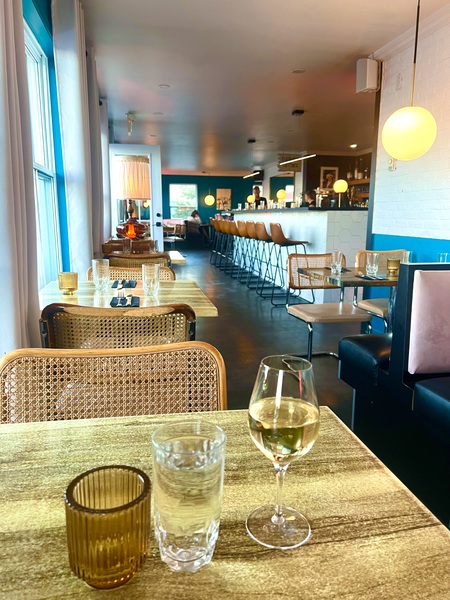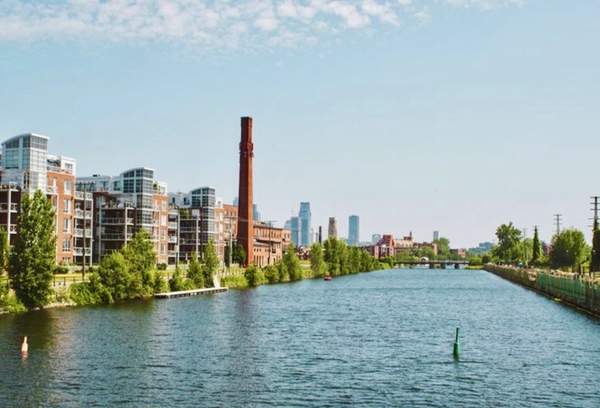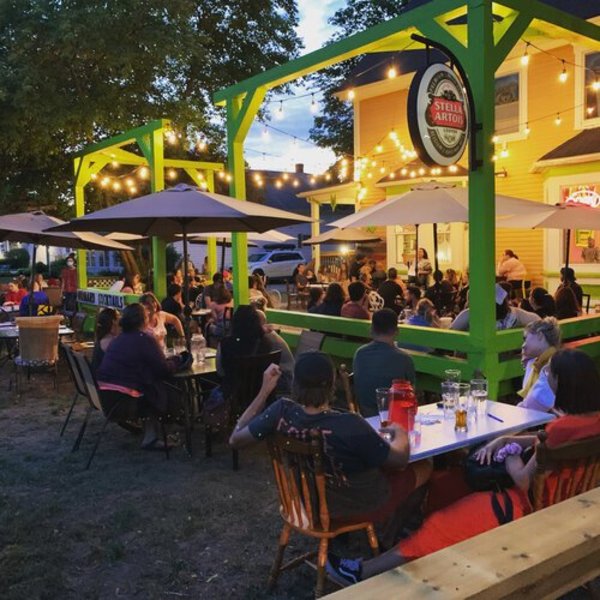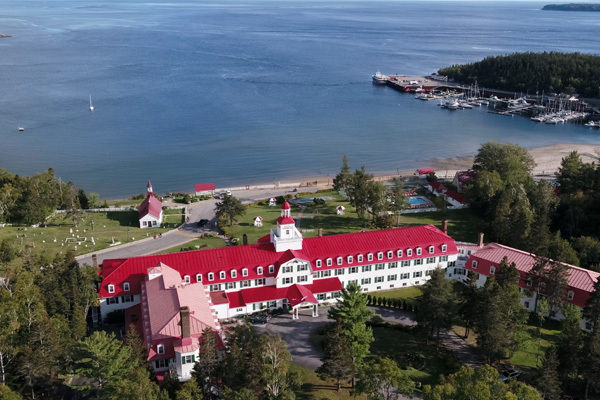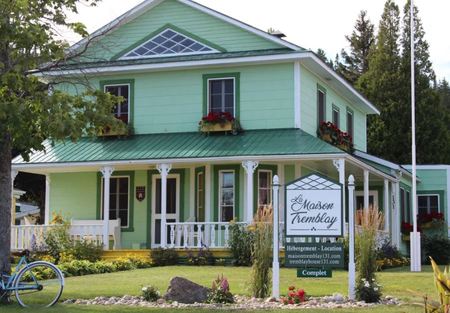Much more than a fond memory of Grandma
In Percé, most people know the story of Thérèse, the grandmother of Billy Bastien and Shaddy Beaudin, two of the four co-owners of the restaurant-bar La Buvette since 2020, in the heart of the village. Set back from the street, its large flowerbed, flanked by a cozy terrace, invites you to browse the menu and explore the decor.
Thérèse Beaudin, a native of Newport who passed away in 2017, was a builder known, among other things, for her hospitality and generosity. It was only natural for the four budding entrepreneurs to name their establishment in her honor.
The menu features original dishes, "local cuisine that changes with the seasons, where cocktails are carefully crafted and wines are lovingly selected," reads the Facebook page. Billy describes it as a place where you can enjoy local products from the sea and the mountains. He also points out that La Buvette Thérèse doesn't present itself as a restaurant or a bar, but rather as a place in between where customers can have brunch, aperitifs, and dinner.
Buvette Thérèse
At the location where La Buvette now stands, there had already been a restaurant, Café Champêtre, since 2000. Billy worked there for 10 years, while pursuing hotel and restaurant management studies, until the then-owners suggested they were planning to sell at the start of the COVID pandemic. Billy gathered three of his friends, including his cousin, all with some experience in the restaurant industry. Together, they developed the Buvette project.
Buvette Thérèse associés
It took guts and boundless determination to launch such an enterprise in the midst of a pandemic. For four young people with no regular income or business history, tackling the financing of a seasonal restaurant open three months a year in Percé was a real challenge, explains Billy. "We had to forget about banks and financial institutions. So we found people who believed in us, and we owe them a lot."
Over the past two years, we've been reconfiguring and redecorating the space. We've created a bar area and equipped the kitchen with a few additions. Nearly thirty people find employment there from May to September.
Oh yes, the website mentions that it's best to make reservations to ensure a table on certain evenings and during brunches.
La Buvette Thérèse
buvettetherese.com
162, QC-132
Travel log


In the summertime, beach enthusiasts will not want to miss visiting the Baie de Beauport. It has been a popular cruising area for years, offering enchanting scenery on the Saint-Lawrence coastline. Every summer, visitors can practice volleyball, soccer, canoeing, kayaking and sailing, or just relax on the beach and have a swim. Baie de Beauport is located only five minutes away from downtown Québec.
At the far edge of the old port and Nouvo Saint-Roch, Gare du Palais serves as Via Rail’s terminal and links Montréal to Québec City. Built in 1915 by the Canadian Pacific Railway, the two-story châteauesque station is similar in design to the Château Frontenac. This magnificent railway station has been designated as a heritage site.
18km from downtown Québec in the Ste-Foy-Sillery-Cap Rouge district, Jean-Lesage International Airport is the world’s gateway into the capital and the eastern and northern regions of the province. It is the second most important airport in the province after Pierre-Elliott Trudeau in Montréal. Close by, the Grand Time Hotel’s two charming establishments offer travellers some well-deserved rest.
the Lachine Canal, you can discover some of the oldest neighbourhoods of the city, the only ones outside the faubourgs east of Old Montréal (now the Village) that were massively built back when horses ruled the streets. As in the Village, there are still carriage gates that lead into stables. This was before the very British urban concept of alleys was introduced, in the second half of the 19th century.
The redevelopment of Griffintown profoundly transformed Notre-Dame St. which had been the area’s main commercial artery in the 19th century. This was preceded by the restructuring of Little-Burgundy, which had largely gentrified the neighbourhood. It’s where the black Anglophone community was concentrated in the early 20th century, and the birthplace of Montréal’s jazz scene. Also, the redevelopment of the outskirts of the canal south of Notre-Dame further transformed the artery where antique dealers elected residence. Cafés, restaurants and trendy bars began appearing, breathing new life into Notre-Dame St. This renewal stretches to the limits of the downtown area, Peel St. and down at Atwater market in Saint-Henri.
In Pointe-St-Charles, you should definitely visit the Saint-Gabriel house. It’s one of the rare 17th century buildings still standing on the island of Montréal, and the oldest farm house as well. Built by François Le Ber around 1660, this beautiful home hosted the King’s daughters until the year 1673. It was also used as a sewing room and small school. The house was largely destroyed by fire in 1693; only the creamery and the outhouse where untouched by the flames. In 1698, it was rebuilt on the foundations of the original buildings’. Today the house is a museum reminding us of Montréal’s lifestyle during the New France era.
Many people of the gay community have chosen to elect residence in Verdun, south of the canal. First in Ile-des-Soeurs, where many artists and creators moved into the new housing developments along the river. Then others moved to the very heart of Verdun, a former suburb now annexed to Montréal, attracted by the affordable prices. This has largely contributed to revitalizing of Wellington St., the main commercial artery of the neighbourhood.
At the confluence of the Muskrat River and the Ottawa River, Pembroke is main city of Renfrew County, with a population of 15,000.
The first European settlers came to the area now known as Pembroke attracted by the growing lumbering operations of the area.
Originally named Miramichi, the village was renamed after Sidney Herbert, First Admiralty Secretary from 1841 to 1845 and son of George Herbert, 11th Earl of Pembroke. It was named seat for Renfrew County in 1861. This set the stage for construction shortly thereafter on the Renfrew County Courthouse, and the arrival of many civil servants, much wealth and much construction.
From 2005 to 2007, the courthouse and (now disused) jail were re-constructed into one building and historic renovations were also completed. Visitors on weekdays can view original 1867 jail cells in the basement, and the original courtroom, complete with a huge replica of the original brass light fixture. County meetings were held here for many years.
Other historic buildings that survive in Pembroke include a historic synagogue, two original hospitals, the Dunlop mansion (Grey Gables Manor Bed & Breakfast), the 'Munroe Block' downtown, and two houses belonging to the White family. A fire in 1918 downtown destroyed many buildings, including the Pembroke Opera House.
Local attractions include 30 historic murals in the downtown area depicting the history of the city, from steam engines to logging.
At the Champlain Trail Pioneer Village and Museum, the history of Ottawa Valley settlers comes alive inside the fully furnished schoolhouse, pioneer log home and church — all built in the 1800s. Other outdoor exhibits include train station, sawmill, blacksmith shop, stonelifter, carriage shed, woodworking shop, bake oven, smokehouse and a 1923 Bickle fire engine. The large museum features artifacts which range from fossils and First Nations arrowheads to furniture, clothing and manufactured products of Pembroke from various eras. There is also a replica of Samuel de Champlain's Astrolabe (he brought the original to the Valley in 1613), an original Cockburn pointer boat, Corliss steam engine, doctor's examination room, fancy parlour rooms, general store, hair salon and more.
The Pembroke Hydro Museum commemorates national hydro-electric development in Pembroke, including the first electric streetlights in Pembroke, and the first municipal building with electric lights (Victoria Hall).
In the heart of the town of Caraquet, the friendly Bobby Comptoir Lunch, with its eclectic decor, offers breakfast and lunch menus that vary daily until 3 p.m. on weekdays. The soups are famous and surprising, and the dishes on the blackboard are always delicious. The coffee alone is worth the detour.
In addition to discovering Acadian history, the Acadian Historical Village offers its restaurant, La Table des ancêtres, located in the Maison Dugas, from June to September. Every day, you can enjoy old-fashioned delicacies, just like Grandma's. The restaurant offers traditional Acadian dishes that vary daily. It is said to serve the best sugar pie in the region.
Pizza lovers are familiar with the pizza at Resto Chez Isa, a short distance from the Acadian Historical Village on Rue du Pont. The seafood pizza is certainly the star of the place. Open daily, guests can enjoy a host of other popular dishes, and the varied lunch menus are a hit.
In the center of Caraquet, with a breathtaking view of the sea, the Origines Cuisine Maritime restaurant welcomes lovers of fine food for a gastronomic experience inspired by the Maritime region. Renowned chef Benjamin Cormier prepares a variety of seafood and local products, constantly evolving with the seasons. Reservations are required on Friday and Saturday evenings.
In a house that's over a century old, the Acadian-Mexican couple has designed the space to allow enthusiasts to enjoy the gastronomic pleasures of Mexican cuisine, Acadian style. Casa Guajillo already has a good reputation among an ever-growing clientele. It's best to make a reservation to ensure a table. Charcoal cooking and wood smoking are the basis of their highly original menu. In Bas-Caraquet, near the area's wonderful beaches, Café Maris Stella is a must-visit for lovers of coffee, pastries, and other sweet treats, in addition to its lunch menus available daily until 4 p.m. The magnificent building offers a mezzanine under the eaves and a seasonal terrace. Fabulous desserts are also made there. Enjoy them on site or order takeout.
On your way to Tracadie-Sheila, on Principale Street, you can't miss a stop at Brasseux de la Côte. Since 2017, microbrewery beer lovers have found a variety of around fifteen products inspired by the Acadian coast, some of which have been honored at festivals and competitions. Go there to learn the science of tasting to better appreciate the flavors.
A visit to these fishing ports of the Acadian Peninsula is a great opportunity to savor Acadian seafood and local produce. In the heart of Shippagan, near the bridge to the islands of Lamèque and Miscou, the Pinokkio restaurant-bar is a must-see with its panoramic view of the islands. Its white or pink pizzas baked in a wood-fired oven, salads, pasta, seafood, and steaks are a delight for food lovers. It offers international and regional cuisine. The mussels marinière in their creamy white wine sauce are particularly delicious. Its terrace is popular in season.
In Haut-Shippagan, near Cielo Glamping, the Hub chez Cielo offers a different concept and a unique culinary and creative experience. The chef's mission is to introduce you to the region's products with the Cielo board concept, where you create your own meal using the boutique's products. The Pearls and Oysters package is also popular. You can also enjoy a coffee from the roastery or savor one of the famous cocktails, wines, and local beers.
On the Lamèque side, the Aloha Boutique Café on Rue Principale, with its Hawaiian-style decor, offers an exotic menu with homemade carrot and turnip soup, corn chowder, Poke Bowls, paninis, bagels, and baguettes, a tempting Aloha salad, and the famous crookies made fresh daily. A lovely back patio welcomes you in season. Its gift shop is stocked with all sorts of practical and fun items.
When a restaurant bears the name of a great wine, you can expect its food to be of superior quality and made with fresh ingredients. The Kabernet Gourmet-pub menu offers a wide variety of appetizers, chef's selections, burgers, meats, and fish, not to mention an extensive dessert menu. The wine and spirits list is astonishingly varied and extensive.
On Miscou Island, the Vieille école de Miscou welcomes tourists staying there for breakfast or those passing through for coffee or a light meal, with a menu that changes seasonally. Don't miss the Tuna Festival in August and its festive menu.
A visit to the Acadian Coast is an excellent opportunity to feast on seafood and discover Acadian cuisine.
In Bouctouche, home of La Sagouine, you can enjoy Acadian dishes and famous seafood at Restaurant La Sagouine, next to the B&B of the same name, right in the heart of town. Tour buses regularly drop off their passengers for an afternoon meal. The breakfasts are particularly renowned.
In Shediac, the lobster capital, seafood is also in the spotlight. In the heart of downtown, on Main Street, La Coast Restaurant has been open since 2012 and has quickly become a favorite with locals and tourists alike. Seafood in various forms is king, but they also serve steaks, burgers, chicken, pasta, and salads. Up to 16 beers and draft beverages are available, in addition to a bottled selection, making it one of the largest in the region. Its breakfasts are renowned.
On the ground floor of the nearby Auberge Gabrièle, Restaurant Gabrièle offers a refined evening dining experience showcasing seafood and local produce. The menu is varied and adapts to the seasons and availability. Breakfasts are served to hotel guests only. The restaurant also offers seafood chowders and other prepared dishes for takeout and from local shops.
Inspired by characters from Alice in Wonderland, the playful bistro Le Moque-Tortue, housed in a large house on Main Street, offers a place to play, escape, and eat, all in one place. With the largest collection of board games in the Atlantic, as well as well-designed escape games, Moque-Tortue offers a varied menu of delicious, well-prepared dishes. Seafood is a particular highlight. The Sunday brunch alone is worth the detour. There's music on the terrace every day during the summer.
Almost across the street from Moque-Tortue, owners Sébastien and Heather offer Adorable Chocolat. The place offers a variety of chocolates made on-site, using simple, natural ingredients, and is also a café where you can enjoy soups, sandwiches, and desserts. In the morning, you'll find fresh brioches and pastries. They now offer alcoholic cocktails in addition to a wide variety of coffees, every day until 6 p.m. As if that weren't enough, these same entrepreneurs acquired the Neptune drive-in theater, back in operation since May 2024, where they will also operate the on-site canteen, under the name Morse et Marteaux, to continue the "Pays des Merveilles" concept. They also obtained the contract to operate the Parlee Beach canteen in Pointe-du-Chêne. Sébastien Després dreamed of a Texan-style meat smoker. He built one, installed in the drive-in canteen. It will be used to smoke the chicken and beef over a wood fire, which will be served in both canteens and in his two restaurants in Shediac.
Is there a name as intimately associated with Acadia as Antonine Maillet? By creating the now-legendary character of La Sagouine in the early 1970s, Antonine Maillet restored the nobility of the popular language of Acadia, the borderless homeland of this French-speaking people born in Atlantic Canada.
After receiving her PhD in literature from Université Laval in 1970, Antonine Maillet taught literature and folklore at Université Laval and then in Montreal between 1971 and 1976. She then worked for Radio-Canada in Moncton as a scriptwriter and host.
In 1976, she was made an Officer of the Order of Canada and promoted to Companion in 1981. In 1979, her novel Pélagie-la-Charette, which evokes the Great Upheaval of 1755 (the genocidal deportation of the Acadians by the British), won the Prix Goncourt, giving her the distinction of being, along with Atiq Rahimi, the only non-European personality to receive this award. That same year, the city of Outremont renamed Wilder Street, where she lives, to Antonine Maillet Avenue, to honor the Prix Goncourt recipient.
In 1985, she was made an Officer of the Ordre des Arts et des Lettres de France, and in 2005 she was inducted into the Order of New Brunswick. Chancellor of the Université de Moncton, she is the author of numerous popular novels and plays. In her works, she is always inspired by the history and folklore of Acadia.
In Ginette Pellerin's documentary "Les possibles sont infinis," dedicated to her, Antonine Maillet speaks publicly for the first time about the great love of her life, Mercédès Palomino, co-founder with Yvette Brind'amour of the Théâtre du Rideau Vert in Montreal, where La Sagouine was first performed in 1972.
In 2018, on the eve of her 90th birthday, Antonine Maillet participated in the second edition of Acadie Love in Caraquet. It was the first time the renowned writer had been involved with an LGBT event.
No visit to Tadoussac is complete without a stroll down Rue du Bord-de-l'Eau to admire the bay and its sheltered marina. This street captures the very soul of Tadoussac. It's easy to understand why locals remain captivated by the views before them - since 2000, Tadoussac Bay has belonged to an exclusive club of the world's most beautiful bays, alongside San Francisco Bay and the Bay of Mont-St-Michel in France.
Standing proudly over the bay is an unmistakable landmark: the elegant white-and-red Hôtel Tadoussac. Everything about this property speaks to its exceptional character - from the vibrant flower gardens and towering trees that surround it, to its history-rich interior with period furnishings, renowned dining room, and breathtaking views.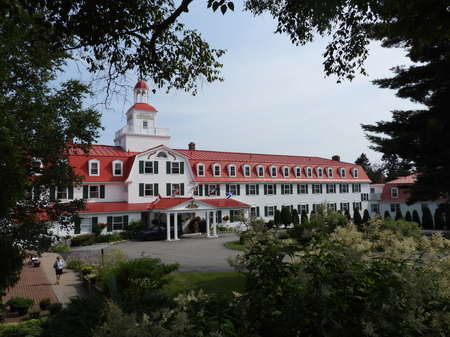
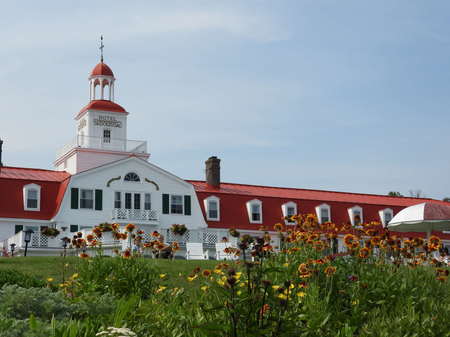
The story of the hotel begins in 1864, when wealthy families from Montreal and Quebec City built the original Hôtel Tadoussac. That first building boasted a grand façade with twelve windows spread across three floors. After changing hands in 1879 for $12,000, it underwent its first major renovation in 1888. Sadly, the original hotel was destroyed in the fall of 1941.
A new chapter began in 1942, when William Hugh Coverdale, an Ontario businessman and president of Canada Steamship Lines, rebuilt the hotel. When it opened its doors on June 27th that year, the new hotel offered 137 rooms to welcome guests.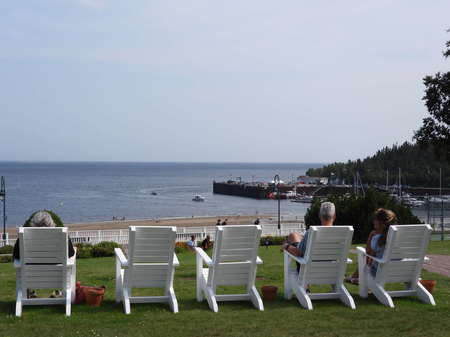
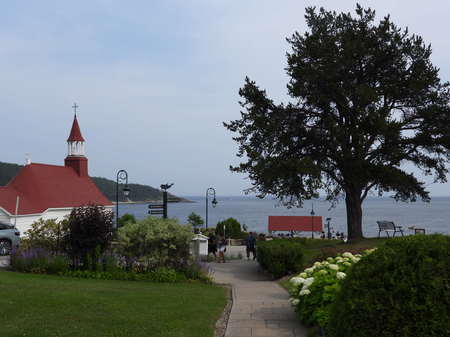
Today's Hôtel Tadoussac carries forward its rich heritage while embracing the future. Though it has changed hands several times, it remains a cherished destination for travelers from around the world.
At the helm since 2000 is Tina Tremblay, who brings her own deep connection to Tadoussac. A graduate of Université Laval's business program in 1981, Tina joined the hotel as financial controller in 1985. She has guided the property through five different ownerships, including three changes between 2005 and 2016, when it was acquired by its current owner, a Canadian real estate management company.
The hotel's reputation as a regional leader in sustainable development owes much to Tina's dedication. Her commitment runs deep - not only does she work on Rue du Bord-de-l'Eau, she calls it home. Born in Tadoussac, she grew up playing on these very grounds and the nearby beach, where her grandmother also lived.
Today's guests can enjoy a full range of activities - from swimming and tennis to hiking and whale-watching excursions. The celebrated Coverdale dining room anchors the culinary experience, complemented by two additional venues: William and Café Lounge Coquart. With 60% of visitors coming from Europe, and year-round conference facilities hosting up to 200 people, the hotel buzzes with international energy.
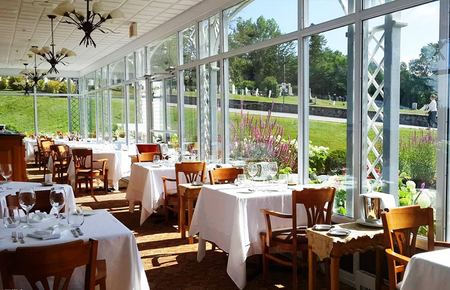
Each June, Tadoussac welcomes the Happening des arts, launching the summer season. In 2025, from June 6th to 8th, artists will once again transform the streets into living galleries, creating works in real time across promenades and outdoor spaces - a truly immersive celebration of art against a stunning backdrop.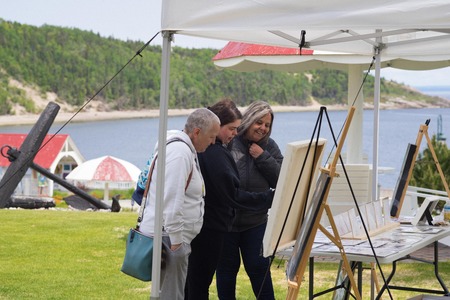
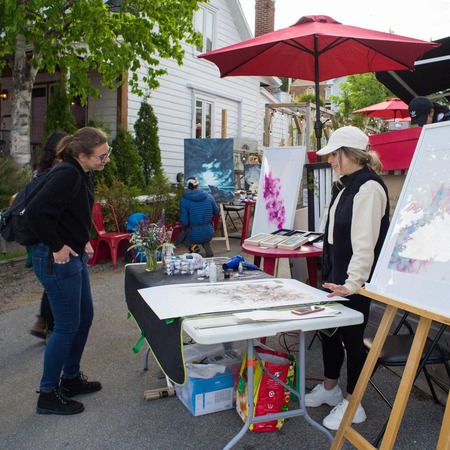
The Hôtel Tadoussac remains a key partner of this event, which grew from the Tadoussac Song Festival that Tina helped create in 1984. Each year, she also welcomes medical students from Université de Sherbrooke, who combine their conference with enjoying the festival's performances.
Tina's connection to local heritage extends beyond the hotel - she co-owns the historic Maison Tremblay, her family's home for four generations. Now available for rental, this century-old house offers a unique gathering space where families can come together, accommodating up to ten guests across five bedrooms.
Hôtel Tadoussac
hoteltadoussac.com
165, Rue du Bord-de-l'Eau
Tadoussac, QC G0T 2A0
(418) 235-4421
By Gaëtan Vaudry
Photo: Héliotrope Editions
At just 31 years of age, his name is already on everyone's lips. Born in Montreal, but a Chicoutimi adoptee by choice, Kevin Lambert is a prolific author collecting the most prestigious awards.
His mantelpiece is already overflowing with numerous accolades, including the best thesis in Arts and Humanities from the University of Montreal, the Pierre L'Hérault Emerging Critic Award, the Discovery Award at the Saguenay−Lac-Saint-Jean Book Fair, the Sade Prize, the CALQ (Quebec Council of Arts and Letters) Prize, the Ringuet Prize, the December Prize, and the 2023 Médicis Prize... to name a few!
Graduating from the University of Montreal with a master's and a doctorate, the writer published his first novel You Will Love What You Have Killed in 2017. In this story set in an unhealthy and morbid Chicoutimi, Kevin Lambert uses hatred as a literary tone and sharply criticizes the xenophobia and homophobia that still prevails in Quebec. The young man already managed to turn many heads, mainly those in the Quebec literary scene. This success set the stage for his second novel, Querelle of Roberval, published a year later. This work - renamed Querelle by his French publisher - narrating the struggle of the workers at the Roberval sawmill against their employer, received a multitude of awards and acknowledgements, propelling Kevin Lambert's name beyond our borders.

Many will remember that in July 2023, Kevin Lambert did not appreciate Quebec's Prime Minister, François Legault, highlighting his latest work Let Our Joy Remain on Twitter. The author fiercely replied to the CAQ leader's literary critique on social media: "Mr. Legault, in the midst of a housing crisis, while your government works to undermine the last bastions protecting us from extreme gentrification in Montreal, promoting my book is pitiful (...) What bothered me was not so much the fact that he reads books that are far from his political ideas or echo chamber, but the interpretation he made of my book in the context of the housing crisis." The two men would subsequently exchange a few messages.
Openly gay, Kevin Lambert, in an interview with La Presse and director René-Richard Cyr in 2021, asserts his desire to contribute to the homosexual affirmation movement in his works: "I like being part of the LGBTQ category," he emphasizes. According to him, the cultural industry imposes changes, adjustments: "Categories don't bother me at all. It's a big machine, the cultural industry, it takes time to move, but it moves.
On November 9, 2023, Kevin Lambert received the Médicis Prize for Let Our Joy Remain, a French literary award established in 1958, intended to honor a novel, a narrative, a collection of short stories, by an author who is beginning or does not yet have a reputation corresponding to their talent. The Médicis comes with a prize of 1000 euros, roughly less than 1500 dollars.
RSS Feed
SubscribeCategories
Tags
Latest Posts
- More than a fond memory of Grandma
- AROUND QUÉBEC CITY
- Along the Lachine Canal
- In the heart of Ottawa Valley
- Dining out in Caraquet
- Dining out
- Acadian cuisine and seafood
- Antonine Maillet
- The Hôtel Tadoussac: a North Shore treasure for over 80 years
- Adopted Chicoutimian, author Kevin Lambert: "I like being part of the LGBTQ category"

